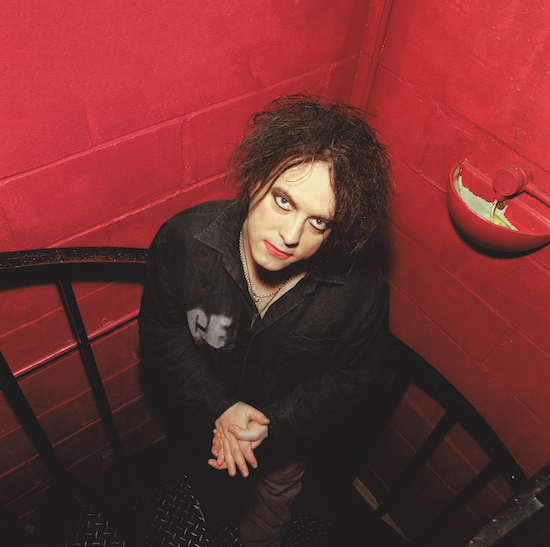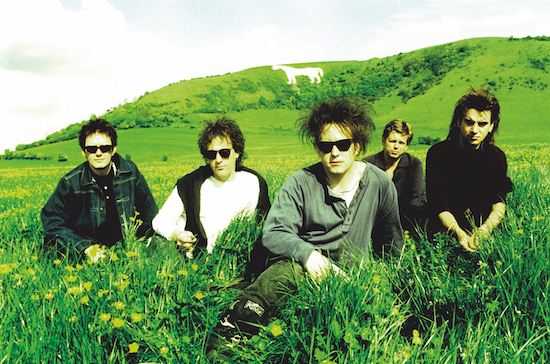The Cure 1995 (c) Tom Sheehan
I have to admit I can’t recall exactly when I first saw my first Robert Smith or someone trying to be him. It almost certainly was during high school in the mid to late 1980s in Southern California, when the small pool of people who were goth or goth-adjacent – and that, too, was a term where I’m not sure of the first time I heard it used musically – were a clutch of folks I was a bit fascinated with from a distance. There’s a couple of examples in my old high school yearbooks, should I ever dig them out again. But even without the specifics in mind, there were things I couldn’t miss.
Nobody was quite like him per se, but you just knew that the combination of hair, dark clothes and lipstick was suggestive; little surprise perhaps that one could read the lyrics to the single ‘Why Can’t I Be You?’ as Smith’s own frenetically humorous consideration of his cult. Looking through The Cure: Pictures of You, a new collection of photos of Smith and varying Cure lineups across time taken by veteran music photographer Tom Sheehan, that suggestion is still there – something at once now strangely cozy and still just a little unexpected, a post-glam rock riff on presentation and identity that in a time of revolting anti-trans panic seems to hit a lot harder just by existing.
Smith provides a fun forward and Sheehan a similar introduction along with short notes on each particular set of shots; you get a sense of now well-established pros who have appreciated each other’s particular work for all this time. While Sheehan never was quite the same key visual architect as Anton Corbijn was for Depeche Mode (not least because unlike Corbijn’s unified role the Cure’s separate video stamp was put in place by Tim Pope), in his role working for Melody Maker he became a favourite of Smith for many good reasons.
Part of my own personal fondness for this book draws on my own memory of when my fandom properly kicked in with Disintegration and what followed. More than once I suddenly recognized an image from a poster I had, an article I remember reading and re-reading, an official band calendar, a general collection of photographs that I had pinned up throughout my cubicle at my student library job. I hadn’t realised it at all then but Sheehan’s work had always been with me to one degree or another after a certain point – even when I started recognising his own name directly via the music press, I didn’t know until looking at this exactly how deep it got.
Sheehan’s work in general stands out for me, and very much so at many points throughout this particular collection, for its sense of colour – a strange thing to say perhaps given he’s equally adept with black-and-white shots. The first set of photos in the chronologically arranged collection are indeed monochrome, taken swiftly for a short news article in 1982 after Smith had reset the band and the idea of what the Cure could be for ‘Let’s Go To Bed’. But those show other skills in turn as well as give a sense of why Sheehan and Smith match so well. The former seems constantly inclined to lean in with a sense of almost intense closeness at points and the latter seems to suddenly spark up for it in turn, able to provide a range of looks and glances throughout later sessions as desired but also often flashing smiles, trademark lipstick in place.

2005, Westside Studios, London. (c) Tom Sheehan
And indeed, the lipstick and the hair and so forth. In an accompanying story of Smith and the band’s artistic life over the years, split up into four separate pieces throughout the collection, Simon Goddard talks in imaginatively engaging fashion about how it emerged out of the Pornography tour and just kept carrying on. The Cure suddenly started scoring legit pop hits (even as Smith occasionally trimmed everything back, as he notably did before the filming of their famed The Cure In Orange concert film – and Sheehan unsurprisingly has shots from that as well, including a great one of the audience looking out from the stage area).
But somehow Smith just had (and seemingly still has) the kind of hair that doesn’t so much grow back quickly as erupt suddenly. And however much it changes and mutates and alters over time it’s still of a piece, almost beyond iconic and more like a formally recognised identification. The makeup can vary – for the most part in these shots both the lipstick and eyeliner are less chaotic than might be seen elsewhere, and in many cases Smith is happily behind shades (and I’m willing to bet that during the promo shots for The Glove, the sheer intake of certain substances was a factor).

Italy, June 1984. (c) Tom Sheehan
Certainly both The Glove shots and a famed series of photos from when Smith was in Siouxsie and the Banshees exude style for days, and there’s surely little question that Smith’s association with that band for years rubbed off style-wise. But two of the best sessions involve the implicit contrast with others also in the shots: Big Country’s Stuart Adamson – both artists in appropriate national team gear from the 1986 World Cup – and the Dinosaur Jr. lineup from 1989. In both cases the other artists look like, well, the other artists, about what one would expect to see. Smith in contrast pulls focus almost just by existing. But of course, it isn’t just that. He worked hard to establish something seemingly anyone could do but nobody could ever quite pull off quite the same way.
What’s particularly telling in a comment from Sheehan refers to one session where Smith has a variety of outfits to hand that lets the photographer figure out what might be best for a shot – and in a way, that’s the key to this collection. It’s a combination of professionals at work and a certain clear sense of actual comfort and experimentation after a certain point. Sure, there’s an understandable sense of getting someone in who will make you ‘look good’ however defined (and more than once it really strikes me just HOW good Smith looks, as well as how he can put into a variety of visual emotions as much as Sheehan can find ways to elaborate variations in a single setting). But Pictures of You has an implicit thesis of sorts that resonates: the idea of the serious artist, however one chooses to define the terms, who found a kind of freedom in embracing celebrity’s glamour while still being exactly who they were.
The Cure: Pictures of You by Tom Sheehan is published by Welbeck


